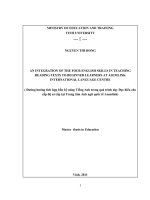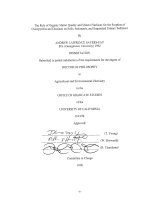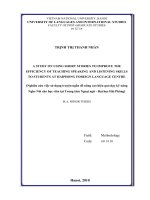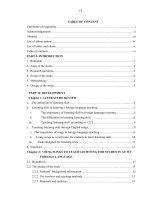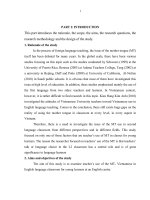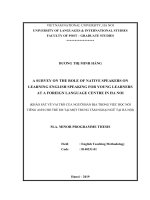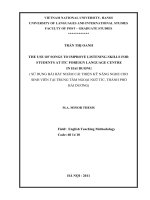A survey on the role of native speaker on learning english speaking for young learners at a foreign language centre in ha noi
Bạn đang xem bản rút gọn của tài liệu. Xem và tải ngay bản đầy đủ của tài liệu tại đây (1.06 MB, 66 trang )
VIET NAM NATIONAL UNIVERSITY, HA NOI
UNIVERSITY OF LANGUAGES & INTERNATIONAL STUDIES
FACULTY OF POST – GRADUATE STUDIES
*****************
DƯƠNG THỊ MINH HẰNG
A SURVEY ON THE ROLE OF NATIVE SPEAKERS ON
LEARNING ENGLISH SPEAKING FOR YOUNG LEARNERS
AT A FOREIGN LANGUAGE CENTRE IN HA NOI
(KHẢO SÁT VỀ VAI TRÒ CỦA NGƯỜI BẢN ĐỊA TRONG VIỆC HỌC NÓI
TIẾNG ANH CHO TRẺ EM TẠI MỘT TRUNG TÂM NGOẠI NGỮ TẠI HÀ NỘI)
M.A. MINOR PROGRAMME THESIS
Field
: English Teaching Methodology
Code
: 8140231.01
Hanoi – 2019
VIET NAM NATIONAL UNIVERSITY, HA NOI
UNIVERSITY OF LANGUAGES & INTERNATIONAL STUDIES
FACULTY OF POST – GRADUATE STUDIES
*****************
DƯƠNG THỊ MINH HẰNG
A SURVEY ON THE ROLE OF NATIVE SPEAKERS ON
LEARNING ENGLISH SPEAKING FOR YOUNG LEARNERS
AT A FOREIGN LANGUAGE CENTRE IN HA NOI
(KHẢO SÁT VỀ VAI TRÒ CỦA NGƯỜI BẢN ĐỊA TRONG VIỆC HỌC NÓI
TIẾNG ANH CHO TRẺ EM TẠI MỘT TRUNG TÂM NGOẠI NGỮ TẠI HÀ NỘI)
M.A. MINOR PROGRAMME THESIS
Field
: English Teaching Methodology
Code
: 8140231.01
Supervisor : Dr. Mai Thị Loan
Hanoi – 2019
DECLARATION
I, Duong Thi Minh Hang, hereby certify that my thesis entitled ―A
survey on the role of native speakers on learning Enlgish speaking for young
learners at a foreign language centre in Ha Noi‖ (Khảo sát về vai trò của
người bản địa trong việc học nói tiếng anh cho trẻ em tại một trung tâm ngoại
ngữ tại Hà Nội) submitted to the Faculty of Post- Graduate Studies,
University of Languages and International Studies, Vietnam National
University, Hanoi is my own work. Documented references have been fully
provided. I have not submitted this thesis for assessment in any other training
institutions.
Hanoi, 2019
Duong Thi Minh Hang
i
ACKNOWLEDGEMENTS
I would like to express my special and sincere thanks to my supervisor,
Ms. Mai Thi Loan, my supervisor, who has patiently and constantly supported
me through the stages of the study, and whose stimulating ideas, expertise,
and suggestions have inspired me greatly through my growth as an academic
researcher.
I also want to express my profound gratitude to all the doctors, lecturers
and staff members of the Faculty of Postgraduate Studies, University of
Foreign Languages and International Studies, Vietnam National University,
Hanoi for their valuable lectures and useful advice that is of a great help for
me to fulfill the thesis.
I would also like to send my deep sense of thanks to all the native and
non-native English teachers and 50 students at the Clever School English
Centre for their cooperation and the valuable information they provided in my
research field. Without their passionate participation and input, the validation
survey could not have been successfully conducted.
My sincere thanks also go to many writers whose ideas are useful hints
for the development of this thesis.
Last but not least, I must express my very profound gratitude to my
family members and to my friends for providing me with unfailing support
and continuous encouragement throughout my years of study and through the
process of researching and writing this thesis. This accomplishment would not
have been possible without them.
iv
ABSTRACT
This research aims at exploring the roles of native speakers for young
learners on learning English speaking at the Clever School English Center.
The primary purpose of the study is an attempt to examine the impact of
native speakers for young learners in speaking lessons and find out effectively
teaching methods of native speakers in speaking lessons. In order to achieve
the aim of the study, the author used the survey questionnaire and class
observation as instruments to collect the data. The results of the data analysis
indicate that native speakers play a very important role because they take part
in the roles of excellent organizers, good motivators, gentle participants and
feedback providers in speaking lessons. The students also participated in the
speaking lessons eagerly and excitedly but the interaction in English among
them was still limited. In addition, the findings of the research suggested
native speakers some teaching methods to teach young learners to speak
English better as well as some equipment improvements supporting native
speakers in teaching.
v
ABBREVIATIONS
CELTA
Certificate in English Language Teaching to Adults
ESL
EFL
English as a second language
English as a foreign language
FL
Foreign language
NESTs
Native English speaking teachers
NNESTs
Non-native English speaking teachers
L2
Second language
TESOL
Teaching English to Speakers of Other Languages
TEYLT
Teaching English to Young Learners and Teenagers
TOEIC
Test of English for International Communication
TOEFL
Test Of English as a Foreign Language
TPR
Total Physical Response
vi
TABLE OF CONTENTS
DECLARATION .............................................................................................. i
ACKNOWLEDGEMENTS........................................................................... iv
ABSTRACT ..................................................................................................... v
ABBREVIATIONS ........................................................................................ vi
LIST OF FIGURES ....................................................................................... ix
TABLE OF CONTENTS............................................................................... vi
CHAPTER 1: INTRODUCTION .................................................................. 1
CHAPTER 2: LITERATURE REVIEW...................................................... 5
2.1 Review of previous studies ......................................................................... 5
2.1.1 Previous studies overseas ......................................................................... 5
2.1.2 Previous studies in Viet Nam ................................................................... 7
2.1.3. Summary ................................................................................................. 8
2.2 Review of theoretical background .............................................................. 8
2.2.1 Speaking ................................................................................................... 8
2.2.2. Native speakers ..................................................................................... 14
2.2.3 Young learners ....................................................................................... 17
2.3 Summary ................................................................................................... 22
CHAPTER 3: RESEARCH METHODOLOGY ....................................... 23
3.1 Restatement of research questions ............................................................ 23
3.2 The setting of the study ............................................................................. 23
3.3 Participants ................................................................................................ 25
3.4 Data collection instruments ....................................................................... 26
3.4.1 Questionnaire ......................................................................................... 26
3.4.2 Class observation of the author .............................................................. 26
3.5 Data collection procedures ........................................................................ 27
vi
2.6 Analysis of data ......................................................................................... 27
3.7 Summary ................................................................................................... 28
CHAPTER 4: DATA ANALYSIS AND FINDING ................................... 29
4.1 Data analysis ............................................................................................. 29
4.1.1 Questionnaire for the students................................................................ 29
4.1.2 Class observation sheet .......................................................................... 33
4.2 Some major findings and discussions ....................................................... 36
4.2.1 The current situation of English speaking lessons with native speakers
of young learners ............................................................................................. 36
4.2.2. The role of native speakers for young learners at the center to speak
English ............................................................................................................. 39
4.3 Possible solutions to improve the roles of native speakers in English
speaking learning of young learners. .............................................................. 41
4.3.1 Reinforcing the teaching method quality of native English teachers .... 41
4.3.2 Investing more equipment and facilities for a more convenient
classroom ......................................................................................................... 41
4.3.3 Motivating the younger learners‘ speaking awareness .......................... 41
4.4 Summary ................................................................................................... 42
CHAPTER 5: CONCLUSION ..................................................................... 43
1. Recapitulation.............................................................................................. 43
2. Concluding remarks .................................................................................... 43
2.1. What is the current situation of English speaking lessons of native
speakers for young learners at the center? ...................................................... 43
2.2. What are the roles of native speakers for young learners at the center to
speak English? ................................................................................................. 44
2.3 What should be done to improve the role of English native speakers in
teaching English speaking skills for young learners at the Center? ............... 45
vii
3. Limitations and suggestion for the further studies ...................................... 46
REFERENCES .............................................................................................. 47
APPENDIX ....................................................................................................... I
APPENDIX 1: ................................................................................................... I
APPENDIX 2: ................................................................................................ IV
viii
LIST OF FIGURES
Figure 3.1: The reality of English speaking teaching lessons ........................... 29
Figure 3.2: The roles of native teachers in speaking lessons............................. 30
Finger 3.3: The favorite activities in speaking lessons by native speakers ..... 32
Finger 3.4: The favorite topics during speaking lesson by native speakers .... 33
ix
CHAPTER 1: INTRODUCTION
1. Rationale of the study
English is more and more important and Hoang (2018) confirmed that
the ability to communicate in English has become a passport to a better job
not only in the tourism and hospitality industries but in many other enterprises
also so English is taught in schools, in universities and in evening foreign
language centers across the country in Viet Nam and there are now more
teachers and students of English than of any other subjects
Although
speaking skill is regarded one of the most difficult aspects of language
learning, many language learners find it difficult to express themselves in
spoken language. And one of the best ways to improve English speaking skill
is learning English as early as possible. With that trend, more and more
parents seek and choose a suitable English center for their children to study
English when they are at the age of kindergarten level and one of the most
attractive factors attracting these parents is native teacher. Native teachers are
considered to be one of the most crucial elements affecting the success of
students learning English speaking.
According to Hoang (2018), ― Various English centres, public and
private, have been established and a large number of foreign and joint venture
language schools, language centers of universities, professional associations,
government agencies, socio-economic organizations and private enterprises
which teach English and use it as the medium of communication have been
set up throughout Vietnam‖. Beside the presence of some famous centers
such as the British Council, the American Apollo, the Cambridge
International Examinations, and the American TOEFL and TOEIC, several
private English-medium schools have been established chiefly in big cities in
1
Vietnam, attracting a considerable number of children from the rich families.
Thanks to the efforts made by them, English in Vietnam has been developed
faster and the quality of English teaching and learning has been increasingly
improved. However, the real quality as well as the role of native speakers at
these medium centers haven‘t been fully studied.
Clever School English Centre is a small English center in Thanh Tri,
Ha Noi. After more than 10-years of establishment and development, this
center has been chosen and trusted by hundreds of parents and children due to
the professional and experienced English teachers. However, the real quality
of native teachers at the center in helping students learning English speaking
has not met their requirements. A lot of young learners here get troubles in
speaking English and for the above reasons, the author decided to choose the
topic ―A survey of the role of native speaker on learning English speaking for
young learners at a foreign language center in Hanoi‖ in the hope of helping
students improve learning English speaking.
2. Aims and objectives of the study
The study aims at investigating the role of native-speakers on learning
English speaking for young learners at the Clever School English Centre.
This overall aim was specified into the following objectives:
- Investigating the current situation of English speaking lessons of
young learners with native speakers at the center
- Finding out the role of native speakers for young learners to speak
English of at the Centre
- Proposing some solutions to improve the role of native speakers for
young learners to learn English speaking at the center
3. Research questions
In order to achieve the above aims, the following research questions are
suggested:
2
- What is the current situation of English speaking lessons of young
learners with native speakers at the center?
- What are the roles of native speakers to young learners at the center to
speak English?
- What should be done to improve the role of English native speakers in
teaching English speaking skills for young learners at the Center?
4. Scope of the study
The study was conducted at the Clever English Center. It attempted to
investigate the issues and problems that arise from fifty young learners in
speaking class with five native speakers as well as finding out how the native
speakers affected on learning English speaking of young learners at the
Center. From above findings, the recommendations for improving the role of
English native speakers in teaching English speaking skills for young learners
at the Center were employed.
5. Method of the study
Both qualitative and quantitative methods were chosen for this study in
order to achieve the tasks mentioned above. A survey questionnaire was
designed for 50 young learners; this is considered as the main instrument to
find out the current status of English speaking teaching lessons of native
speakers for young learners at the center. Besides, qualitative method was
conducted with classroom observations which aimed to assess the roles of
native speakers in teaching performance on speaking skill. This was a
necessary step for the researcher to double – check what was happening in
speaking lessons. After all, the data was collected, sorted, and analyzed
quantitatively data to obtain realized results.
To end with, from the collected data, the recommendations for
improving the role of English native speakers in teaching English speaking
skills for young learners at the Center were drawn out.
3
6. Significance of the study
It is supposed that the study will contribute more understanding on the
roles of native speakers both theoretically and practically. The first point is
that the study will investigate the current situation of English speaking lessons
of native speakers for young learners as well as the effects of them at the
medium English center. From that, the findings of the study will be shared
among English teaching centers and some positives solutions helping young
learners to speak English well will be applied. Especially, the findings will be
used as a data base for further study.
7. Structure of the research
The study is organized three parts as follows:
Chapter 1, INTRODUCTION, presents rationale, objectives, research
questions, scope, methods, significance, and design of the study.
Chapter
2, LITERATURE REVIEW, presents a review of literature and
theoretical background and related studies.
Chapter 3, METHODOLOGY, introduces the research context and
methodology of the study including the context, the subject, the data collection
instruments, data collection procedure, and data analysis.
Chapter 4, FINDINGS AND DISCUSSION, gives a detailed presentation
of data and detailed description of data analysis. This focuses on presenting,
analyzing and discussing the results obtained from the study based on the survey
questionnaire and class observation. Besides, the chapter also presents some
discussion and interpretations of the findings of the study, and then gives possible
suggestions for native speakers, young learners and managing board of the center.
Chapter
5, CONCLUSION, offers a summary of the key findings,
implications, limitations, and future directions for further study.
4
CHAPTER 2: LITERATURE REVIEW
In this section, previously conducted researches in the detail fields of
the role of native speakers for English learners as well as will be presented
and discussed. This must be done in order to place the thesis in the context
relevant to the research which will be conducted. Furthermore, it will provide
the readers with some basic knowledge of the background and present state of
this field of research.
2.1 Review of previous studies
The topic of NESTs and NNSTs has been received interests and
attentions of many researchers and studies. This part briefly reviews some
studies relating my thesis in both Viet Nam and Overseas.
2.1.1 Previous studies overseas
In this part, the researcher shows that the studies conducted in some
countries where English is taught as a foreign language. They are the studies
by Dr Ismet SAHIN (2005), Yuko Goto Butler (2007), Rahmila Murtiana
(2011), Omar Al-Nawrasy (2013).
Dr Ismet SAHIN (2005) investigated the effect of native speaker
teachers of English on the attitudes and success of EFL learners in Turkish
setting. The results based the analyzed questionnaires confirmed that the
learners who were exposed to native speaker teachers of English had more
positive attitudes towards target language community and were more
successful in English lessons compared to those who were not exposed to any
native speaker teachers of English. However, the study did not make clear the
EFL learners were young or old.
Yuko Goto Butler (2007) aimed to identify perceptional factors that
native speakers were the ideal language teacher. This study focused on
5
Japanese elementary school teachers who had been asked to introduce English
activities in their classes. Based on a detailed questionnaire, the study found
their self-assessed English proficiency levels, their attitudes towards
nonstandard forms of English, and their sense of pride in their own language
and cultural heritage. However, it is unclear to what extent the present study‘s
findings can be applied to other teaching contexts.
Rahmila Murtiana (2011) aimed to investigate the students‘ perceptions
of native speaker teachers (NST) and non-native speaker teachers (NNST). To
collect the data, the researcher developed a set of questionnaire and from the
data analysis, it revealed that the students had positive attitude toward both
native speaker and non-native speaker teachers. However, the students also
encountered some problems during the learning process with both native and
non-native teachers. Thereby, the writer attempted to put forward several
ideas related to teacher education and professional development, expecting
that non-native teachers would be able to make the most of their potentials.
The study only focused on the perceptions of students of NSTs and NNSTs at
a university in Indonesia for learning English language in general.
Omar Al-Nawrasy (2013) investigated the effect of the native English
language teachers in comparison with nonnative English language teachers on
the tenth grade students‘ achievement in speaking skills. The instrument of
the study was a speaking test implemented at the end of term one of the
academic year 2008/2009. The findings revealed that there was no significant
difference among students‘ overall speaking achievement test scores and the
author confirmed that a trained, proficient and kind teacher who enjoyed
his/her job would be effective and popular with students, regardless where
they were from. However, the study only focused on the students in the public
schools where exposure to English was limited to few hours per week, and
where chances to speak communicatively were also limited.
6
As we know, different research method and different research
context result in different findings. And we can recognize that there are
many factors affecting English speaking skill and native teacher is one of the
most important factors helping the learners learn to speak English well.
However, the roles of native speakers for young learners in learning speaking
English at private centers have not been fully mentioned yet.
2.1.2 Previous studies in Viet Nam
The students‘ perception of NESTs and NNESTs is not a new area with
researchers in the world as well as in Viet Nam. Some domestic studies have
been selected and discussed here:
Walkinshaw and Duong (2012) had a paper examining a common
belief that learners of English as a foreign language prefer to learn English
from native-speaker teachers rather than non-native speakers of English. In
addition, it investigated the relative value ascribed by Vietnamese EFL
students to native and non-native speakers compared with other professional,
personal, pedagogical, cultural and linguistic qualities that are the hallmark of
a competent language teacher. However the limitation of the study was that
the data were collected from tertiary institutions only.
Le Pham Hoai Huong ( 2013) discussed the game activities that were
used in primary English classes in a center in a city in Vietnam. Video
recording the classes and interviewing the teachers showed that various play
activities, for example, bingo, miming, hangman, and TPR (Total Physical
Response) activities were employed in these classes. The paper reported the
findings of a small scale study which could not be generalized. Under those
circumstances, the suggestions were also offered regarding kinds of game
activities to be employed and how to use them to target certain skills and
language areas in primary English classes. Different from that, the roles of
teachers in the center were not made clear NESTs and NNESTs.
7
Tuan, N. H., & Mai, T. N. (2015) investigated the problems that the
students at a public High School experienced in speaking lessons and the
factors affecting their speaking performance. The research instruments used in
this study were questionnaires and class observation. As the results, the study
indicated that the students faced many problems in learning speaking English
at a high school and one of the most important factors is because of NNESTs.
On the contrary, the recommendations of the research did not include the
suggestions that native teachers should be hired to teach English at school to
improve the students‘ attitude and motivation as well their pronunciation.
To put in a nutshell, the author mentioned the above domestic studies
aiming that NESTs are better than NNESTs at teaching speaking skill and
game activities in primary English classes are needed.
2.1.3. Summary
In the light of the studies above, we may conclude that native speaker
teachers have an effect on students‘ attitudes and motivation. If their effect is
positive, they can contribute to their students‘ achievement, in a way. Some
gaps, notwithstanding, have not been filled up to meet our curiosity on native
speaker teachers on teaching speaking skill. In this thesis, the author will
hopefully fill out the crucial role of native teachers for younger learners at
English private center on teaching speaking skill.
2.2 Review of theoretical background
2.2.1 Speaking
1.2.1.1 Definition of speaking
There are a lot of definitions of the word ―speaking‖ that have been
suggested by the researchers in language learning. In Webster New World
Dictionary, speaking is to say words orally, to communicate as by talking, to
make a request, and to make a speech (Nunan, 1995). According to Chaney
8
(1998), speaking is the process of making and sharing meaning by using
verbal and non-verbal symbols in different contexts. Brown (1994) and Burns
and Joyce (1997) defined speaking as an interactive process of making
meaning that includes producing, receiving, and processing information. Its
form and meaning are dependent on the context in which it occurs, including
the participants themselves, their collective experiences, the physical
environment, and the purposes for speaking. It is often spontaneous, openended, and evolving. However, speech is not always unpredictable. Language
functions (or patterns) that tend to recur in certain discourse situations (e.g.,
declining an invitation or requesting time off from work), can be identified
and charted (Burns & Joyce, 1997). Speaking requires that learners not only
know how to produce specific points of language such as grammar,
pronunciation, or vocabulary (linguistic competence), but also that they
understand when, why, and in what ways to produce language (sociolinguistic
competence). Finally, if students want to be able to speak fluently in
English, they need to be able pronounce phonemes correctly, use appropriate
stress and intonation patterns and speak in connected speech (Harmer, J. 2007).
To put it simply, the author think that speaking as an interactive process
of making meaning that includes producing, receiving, and processing
information suitably
in a defining context. For an effectively English
speaking lesson, students need to speak fluently and correctly in English. It
must be remembered that the interaction between teacher and students and
students with students is the key point to decide how effective the English
speaking lesson is.
1.2.1.2 Classroom speaking activities
According to Turk, Christopher (1985), speaking process includes three
main steps in speaking class as followings:
9
Pre speaking
Pre speaking begins before students actually speak. It also provides
opportunities for students to plan and organize for speaking. Some purposes
fro pre- speaking are that students generate and explore ideas for speaking
topics through activities. Moreover, pre speaking focus learners‘ attention to
speaking. The stage is to do with raising metacognitive awareness of students
about speaking. It has two main purposes: to encourage learners to a speaking
development and prepare learners to approach a specific speaking task in a
lesson by the teacher. In addition, the teacher prepares students for the actual
speaking activity and asks them to do some language awareness activities
such as vocabulary/grammar related to asking and giving directions.
While speaking
The purpose of real communication is to accomplish a task, such as
conveying a telephone message, obtaining information, or expressing an
opinion. Authentic communication involves an information gap; each
participant has information that the other does not have. In addition, to
achieve their purpose, participants may have to clarify their meaning or ask
for confirmation of their own understanding. To create classroom speaking
activities that will develop communicative competence, instructors need to
incorporate a purpose and an information gap and allow for multiple forms
of expression. Instructors need to combine structured output activities,
which
allow
for
error
correction
and
increased
accuracy,
with
communicative output activities that give students opportunities to practice
language use more freely.
Post-speaking
Following speaking experiences, both formal and informal, it is
important to have students reflect upon their performance because students
10
who have opportunities to reflect upon their speaking experience grow in their
abilities to speak effectively. Additionally, post-speaking activities serve to
set goals for improvement. When students reflect upon their performance,
they begin to recognize what they have done well and where they require
improvement. ln discussing or developing criteria for assessing a variety of
speaking experiences, both teachers and peers may be invited to comment.
Peers may comment through a structure similar to a writing conference and
may give oral feedback, written feedback, or a combination of the two.
Conferences may be guided by specific questions determined by the teacher
or may take the form of conversation between peers.
And during these above steps, a number of widely-used categories of
speaking activity should be implemented in the classroom by teacher and
students ( Hammer, 2007). These activities include acting from a script,
communication games, discussion, Prepared talks, questionnaires, simulation
and role-play.
*Acting from a scrip: The teacher can ask the students to act out scenes
from plays and/or their course books, sometimes filming the results. Students
will often act out dialogues they have written themselves.
* Communication games: There are many communication games, all of
which aim to get students talking as quickly and fluently as possible. Two
particular categories are worth mentioning here: information-gap games and
television and radio games.
*Discussion: this ranges from highly formal, whole-group
staged
events to informal small-group interactions which include Buzz groups,
Instant comment, Formal debates, Unplanned discussion and Reaching a
consensus. Each of discussion has their own benefit.
11
*Prepared talks: One popular kind of activity is the prepared
talk, where a student (or students) makes a presentation on a topic of
their
own
choice.
Such talks
are
not
designed
for
informal
spontaneous conversation; because they are prepared, they are more
'writing-like' than this. However, if possible, students should speak from
notes rather than from a script.
*Questionnaires: Questionnaires are useful because, by being preplanned, they ensure that both questioner and respondent have something
to say to each other. Depending upon how tightly design they are, they may
well encourage the natural use of certain repetitive language patterns – and
thus can be situated in the middle of our communication continuum. Students
can design questionnaires on any topic that is appropriate . As they do so,
the teacher can act as a resource, helping them in the design process. The
results obtained to questionnaires can then form the basis for written work,
discussions or prepared talks
*Simulation and role-play: This activity can be used to encourage
general oral fluency or to train students for specific situations, especially
where they are studying English for specific purposes (ESP).When students
are doing simulations and role-plays, they need to know exactly what the
situation is, and they need to be given enough information
about the
background for them to function properly. Of course, we will allow them to
be as creative as possible, but if they have almost no information, they may
find this very difficult to do.
Among the above activities mentioned by Hammer (2007),
communication games, discussion, prepared talks, questionnaires, simulation
and role-play are regularly used in the English speaking classrooms but how
12
often the teachers organize them and how effectively they use them we will
explore in the case of this study.
Generally speaking, the author supposes that three steps such as prespeaking, while-speaking and post-speaking must be followed but whether
they are effective or not totally depends on the classroom speaking activities
between teacher and students.
1.2.1.3 Factors that cause speaking difficulties to EFL learners
According to Ur (1996), there are many factors that cause difficulty in
speaking, and they are inhibition, lack of topical knowledge, low
participation, and mother-tongue use.
Inhibition is the first problem that students encounter in class. When
they want to say something in the classroom they are sometimes inhibited.
They are worried about making mistakes and fearful of criticism.
The second problem is that learners complain that they cannot
remember anything to say and they do not have any motivation to express
themselves
The third problem in the speaking class is that the participation is very
low. In a class with a large number of students, each student will have very
little time for talking because just one student talks at a time and the other
students try to hear him/her. In the speaking class, some learners dominate the
whole class while others talk very little or never speak.
The last problem related to the speaking ability is that when some
learners share the same mother-tongue, they try to use it in the speaking class
because it is very easy for them.
With the general view, Hammer (2007) showed three main important
factors causing students‘ difficulty. They are students' personalities, What the
teacher does, Creating successful classrooms and Behavior norms.
13
Students' personalities are closely bound up with their levels of selfesteem - how they feel about themselves and what level of comfort and selfconfidence
they are experiencing. Self- esteem is influenced by a large
number of factors such as students' experiences in their families, learning
expectations and approval which a student's self-esteem may result partly
from the way the teacher behaves.
What the teacher does: A lot student will depend on how teachers,
behave in class. If they do not - or if they see the teacher as unprepared and
uncertain about what to do in their lessons - they are far more likely to lose
interest and if they lose interest, their incentive to maintain their level of
concentration is lessened, and if that happens, they are more likely to become
disconnected with what is going on.
Creating successful classrooms: Problem behavior rarely occurs in
successful language classrooms. When students are engaged, have a
reasonable level of self-esteem and are experiencing success, there is no
incentive for them to behave badly, disrupt lessons or create barriers
between themselves and their teacher or their peers. Teachers need, then, to
examine how they can try to ensure that the classroom is a success-oriented
environment. .
In summary, the factors causing speaking difficulties to EFL learners
come from student personality, teacher activities, learning environment
2.2.2. Native speakers
1.2.2.1 Definition
There are many different definitions of a native speaker by researchers.
The following definitions are presented to help the readers make clear who
are native speakers.
14
Bloomfield (1933) states that ―the first language a human being learns
to speak in their native language, they are a native speaker of this language‖.
Moreover, McArthur (1992) takes up Bloomfield‘s early definition of a
native speaker and says that it is ―a person who has spoken a certain language
since early childhood‖.
Cook (1999) adds that native speakers are even capable of producing
new sentences that they have not heard before. All these features can be seen
with regard to pronunciation.
According to Cambridge University Press (2009), a native speaker is
someone who has spoken a particular language since he or she was a baby,
rather than having learned it as a child or an adult.
To sum up, a native speaker is a person who speaks the first language
as their mother tongue and does not change in any other languages when
growing up. Moreover, defining the native speaker becomes clear by referring
to the language identity and the use of language indicates who the speaker is.
1.2.2.2 Roles of native speakers in teaching English speaking
From the point of view of Cook, V. (1999), native speakers play the
role of a pronunciation model and a language source in teaching language.
According to Brown (2001), teacher can play many roles in the course of
teaching such as a controller, a director, a manager, a facilitator, and a source.
According to Harmer (2007) a teacher is like ―a gardener because
he/she plants the seeds and watches them grow‖. Students are the field and the
seed is seen as the knowledge planted by educators. As a gardener takes very
good care of the roses, flowers, waters them when necessary, the
teacher also plays different roles in the lives of the students not only by
planting knowledge in them but also acting as a model in the classroom and
outside it with their personal lives. In English language teaching classes,
15
